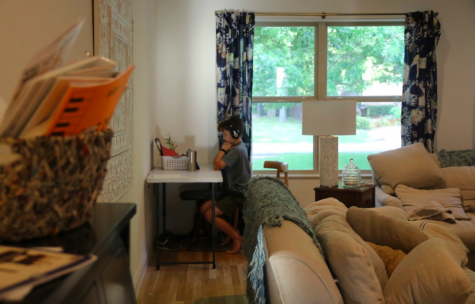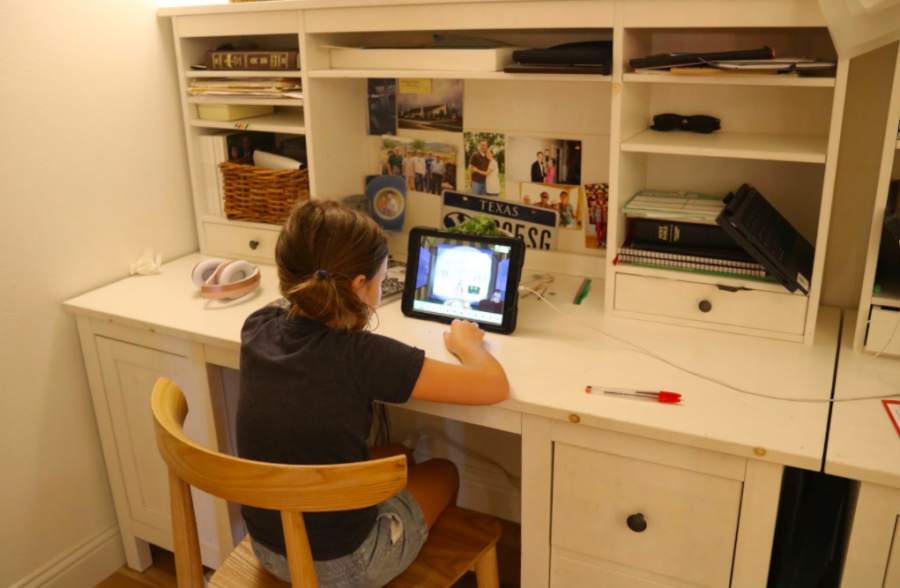Virtual environment provides new experiences for elementary, middle school learners to start school year
Wilson Elementary second grader Eliza Harris works on her math work on Friday. Due to online school, young learners have had to adjust how they learn interactively.
September 1, 2020
For Coppell ISD students, the transition to remote learning means that the kitchen table, bedroom, and backyard all double as a classroom, making it increasingly difficult to separate home life from school.
From kindergarten to 12th grade, each grade level requires different skills from its students, but at earlier levels, an emphasis is placed on easing the transition between home and school and a smaller number of students in class, so students can interact and create connections with one another.
However, students such as Coppell Middle School North eighth grader Corbin Chen believe that remote curriculum makes this interaction significantly more difficult.
“I strongly dislike remote learning because I work better through interaction and it’s harder to collaborate with peers or ask teachers questions about an assignment,” Chen said. “After Labor Day, I plan on returning to in-person learning because my grades have been suffering.”
The option for in-person learning for all grade levels will begin on Sept. 8.
Although Coppell ISD encouraged teachers at all levels to integrate relationship building activities into the first week of school, some students are finding it difficult to make new friends during remote learning as they would in-person.
“Usually, during school, I focus on my work and not my friends, but last year I made a lot of new friends,” Coppell Middle School East seventh grader Medha Kanamarlapudi said. “It will be harder to make friends this year because even in [Zoom] breakout rooms, no one really talks and people are just on their phones. I think it would be different if it was in-person, because there are more distractions and everyone is more laid-back.”
Teachers at all levels are currently required to assign work they think most students could reasonably get done within their class time and submit by midnight. This allows students to adjust to the transition and still produce quality work. Since every child learns at a different pace, Kanamarlapudi and other students might have less rigorous work than they were used to.
“The curriculum is repetitive and doesn’t seem to challenge me as a learner,” Kanamarlapudi said. “I wish teachers would give us more work to consume our time.”
Remote learning provides a more flexible work environment, allowing time for more breaks throughout the day. Since teachers are not in the same room as students, they do not have as much control over what students are doing and are sometimes unaware of what is going on behind the screen.
Due to the increased amount of video calls because of remote learning, there has been a proven increase in students’ cognitive load. Experts, such as Laura Dudley, a behavior analyst at Northeastern University, suggest taking breaks between calls. Dudley mentions an idea called “Zoom fatigue” that can be applied to elementary and middle school learners. The term claims that sitting down for long periods of time is not part of the routine that younger students are used to.

“Something that I find helpful is taking a lot of breaks,” Chen said. “Since we are staring at a screen all day long, time feels like it is going by slower, which makes me feel bored and tired.”
In elementary school, it is a priority for educators to have engaging and interactive lessons. With these types of lessons, students may feel less tempted to get sidetracked.
“I attribute any success to the educators for making the lessons fun and engaging and developmentally appropriate for our elementary kids,” Mockingbird Elementary Principal Laura Flynn said. “Children are not only learning academic skills, but social skills as well, like taking turns, talking respectively and valuing each other’s opinion.”
Remote learning is not only new for students, but teachers as well. Due to remote learning, students may be becoming more understanding of the role their teachers play in their education and more grateful about utilizing learning resources like technology.
“The main difference from other districts is that CISD personal touch and going the extra mile,” Flynn said. “I know educators have made home visits to provide extra materials and there are Zoom sessions with students, teachers and family members if a learner needs extra support.”
With more time in a virtual environment, CISD schools are able to identify areas needing improvement in regards to instruction.
“We have learned the benefit of increased collaboration,” Flynn said. “Teachers are collaborating with other teachers. We have learned a lot about technology. We can still apply these skills when we do face to face learning as well. It has given us more creative ideas about how to meet every child’s needs in the classroom.”
Follow Sapna (@sapnaamin6) and @CHSCampusNews on Twitter.












